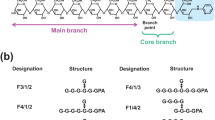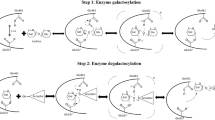Abstract
Xyloglucan-specific endo-β-1,4-glucanases (Xegs, EC 3.2.1.151) exhibit high catalytic specificity for β-1,4 linkages of xyloglucan, a branched hemicellulosic polysaccharide abundant in dicot primary cell walls and present in many monocot species. In nature, GH12 Xegs are not associated with carbohydrate-binding modules (CBMs), and here, we have investigated the effect of the fusion of the xyloglucan-specific CBM44 on the structure and function of a GH12 Xeg from Aspergillus niveus (XegA). This fusion presented enhanced catalytic properties and conferred superior thermal stability on the XegA. An increased k cat (chimera, 177.03 s−1; XegA, 144.31 s−1) and reduced KM (chimera, 1.30 mg mL−1; XegA, 1.50 mg mL−1) resulted in a 1.3-fold increase in catalytic efficiency of the chimera over the parental XegA. Although both parental and chimeric enzymes presented catalytic optima at pH 5.5 and 60 °C, the thermostabilitiy of the chimera at 60 °C was greater than the parental XegA. Moreover, the crystallographic structure of XegA together with small-angle X-ray scattering (SAXS) and molecular dynamics simulations revealed that the spatial arrangement of the domains in the chimeric enzyme resulted in the formation of an extended binding cleft that may explain the improved kinetic properties of the CBM44-XegA chimera.






Similar content being viewed by others
References
Allen MP, Tildesley DJ (1987) Computer simulation of liquids. Claredon Press, Oxford
Benko Z, Siika-aho M, Viikari L, Reczey K (2008) Evaluation of the role of xyloglucanase in the enzymatic hydrolysis of lignocellulosic substrates. Enzym Microb Technol 43(2):109–114
Berendsen HJC, Postma JPM, van Gunsteren WF, Hermans J (1981) Interaction models for water in relation to protein hydration. Intermol Forces:331–342
Bragatto J, Segato F, Squina FM (2013) Production of xylooligosaccharides (XOS) from delignified sugarcane bagasse by peroxide-HAc process using recombinant xylanase from Bacillus subtilis. Ind Crop Prod 51:123–129
Buckeridge MS, Crombie HJ, Mendes CJM, Reid JSG, Gidley MJ, Vieira CCJ (1997) A new family of oligosaccharides from the xyloglucan of Hymenaea coubaril L. (Leguminosae) cotyledons. Carbohydr Res 303(2):233–237
Bussi G, Donadio D, Parrinello M (2007) Canonical sampling through velocity rescaling. J Chem Phys 126(1):014101
Bycroft M, Bateman A, Clarke J, Hamill SJ, Sandford R, Thomas RL, Chothia C (1999) The structure of a PKD domain from polycystin-1: implications for polycystic kidney disease. EMBO J 18(2):297–305
Carpita NC, McCann MC (2000) The cell wall. In: Buchanan BB, Gruissem W, Jones R (eds) Biochemistry and molecular biology of plants. Amercian Society of Plant Physiologists, Rockville, pp 52–109
Charnock SJ, Bolam DN, Turkenburg JP, Gilbert HJ, Ferreira LMA, Davies GJ, Fontes CMGA (2000) The X6 “thermostabilizing” domains of xylanases are carbohydrate-binding modules: structure and biochemistry of the Clostridium thermocellum X6b domain. Biochem 39(17):5013–5021
Chen VB, Arendall WB, Headd JJ, Keedy DA, Immormino RM, Kapral GJ, Murray LW, Richardson JS, Richardson DC (2010) MolProbity: all-atom structure validation for macromolecular crystallography. Acta Crystallogr D 66:12–21
Cota J, Oliveira LC, Damasio ARL, Citadini AP, Hoffmam ZB, Alvarez TM, Codima CA, Leite VBP, Pastore G, de Oliveira-Neto M, Murakami MT, Ruller R, Squina FM (2013) Assembling a xylanase-lichenase chimera through all-atom molecular dynamics simulations. Biochim Biophys Acta Protein Proteomics 1834(8):1492–1500
Damasio ARL, Ribeiro LFC, Ribeiro LF, Furtado GP, Segato F, Almeida FBR, Crivellari AC, Buckeridge MS, Souza TACB, Murakami MT, Ward RJ, Prade RA, Polizeli MLTM (2012) Functional characterization and oligomerization of a recombinant xyloglucan-specific endo-β-1,4-glucanase (GH12) from Aspergillus niveus. Biochim Biophys Acta Protein Proteomics 1824(3):461–467
Davies GJ, Wilson KS, Henrissat B (1997) Nomenclature for sugar-binding subsites in glycosyl hydrolases. Biochem J 321(2):557–559
Emsley P, Lohkamp B, Scott WG, Cowtan K (2010) Features and development of Coot. Acta Crystallogr D 66:486–501
Essmann U, Perera L, Berkowitz ML, Darden T, Lee H, Pedersen LG (1995) A smooth particle mesh Ewald method. J Chem Phys 103(19):8577–8593
Furtado GP, Ribeiro LF, Lourenzoni MR, Ward RJ (2013) A designed bifunctional laccase/β-1,3-1,4-glucanase enzyme shows synergistic sugar release from milled sugarcane bagasse. Protein Eng Des Sel 26(1):15–23
Gasteiger E, Hoogland C, Gattiker A, Duvaud S, Wilkins MR, Appel RD, Bairoch A (2005) Protein identification and analysis tools on the ExPASy server. In: Walker JM (ed) The proteomics protocols handbook. Humana Press, New York, pp 571–607
Gloster TM, Ibatullin FM, Macauley K, Eklöf JM, Roberts S, Turkenburg JP, Bjørnvad ME, Jørgensen PL, Danielsen S, Johansen KS, Borchert TV, Wilson KS, Brumer H, Davies GJ (2007) Characterization and three-dimensional structures of two distinct bacterial xyloglucanases from families GH5 and GH12. J Biol Chem 282(26):19177–19189
Grishina IB, Woody RW (1994) Contributions of tryptophan side-chains to the circular-dichroism of globular proteins—exciton couplets and coupled oscillators. Faraday Discuss 99:245–262
Guex N, Peitsch MC (1997) SWISS-MODEL and the Swiss-PdbViewer: an environment for comparative protein modeling. Electrophoresis 18(15):2714–2723
Guillen D, Sanchez S, Rodriguez-Sanoja R (2010) Carbohydrate-binding domains: multiplicity of biological roles. Appl Microbiol Biotechnol 85(5):1241–1249
Hammersley AP, Brown K, Burmeister W, Claustre L, Gonzalez A, McSweeney S, Mitchell E, Moy JP, Svensson SO, Thompson AW (1997) Calibration and application of an X-ray image intensifier/charge-coupled device detector for monochromatic macromolecular crystallography. J Synchrotron Radiat 4:67–77
Hess B, Bekker H, Berendsen HJC, Fraaije JGEM (1997) LINCS: a linear constraint solver for molecular simulations. J Comput Chem 18(12):1463–1472
Hess B, Kutzner C, van der Spoel D, Lindahl E (2008) GROMACS 4: algorithms for highly efficient, load-balanced, and scalable molecular simulation. J Chem Theory Comput 4(3):435–447
Ichinose H, Araki Y, Michikawa M, Harazono K, Yaoi K, Karita S, Kaneko S (2012) Characterization of an endo-processive type xyloglucanase having a β-1,4-glucan-binding module and an endo-type xyloglucanase from Streptomyces avermitilis. Appl Environ Microbiol 78(22):7939–7945
Ishida T, Yaoi K, Hiyoshi A, Igarashi K, Samejima M (2007) Substrate recognition by glycoside hydrolase family 74 xyloglucanase from the basidiomycete Phanerochaete chrysosporium. FEBS J 274(21):5727–5736
Khademi S, Zhang DC, Swanson SM, Wartenberg A, Witte K, Meyer EF (2002) Determination of the structure of an endoglucanase from Aspergillus niger and its mode of inhibition by palladium chloride. Acta Crystallogr D 58:660–667
Kirk O, Borchert TV, Fuglsang CC (2002) Industrial enzyme applications. Curr Opin Biotechnol 13(4):345–351
Kittur FS, Mangala SL, Rus’d AA, Kitaoka M, Tsujibo H, Hayashi K (2003) Fusion of family 2b carbohydrate-binding module increases the catalytic activity of a xylanase from Thermotoga maritima to soluble xylan. FEBS Lett 549(1–3):147–151
Liu LW, Cheng J, Chen HG, Li XQ, Wang SY, Song AD, Wang MD, Wang B, Shen JW (2011) Directed evolution of a mesophilic fungal xylanase by fusion of a thermophilic bacterial carbohydrate-binding module. Process Biochem 46(1):395–398
Luis AS, Venditto I, Temple MJ, Rogowski A, Basle A, Xue J, Knox JP, Prates JAM, Ferreira LMA, Fontes CMGA, Najmudin S, Gilbert HJ (2013) Understanding how noncatalytic carbohydrate binding modules can display specificity for xyloglucan. J Biol Chem 288(7):4799–4809
Miller GL (1959) Use of dinitrosalicylic acid reagent for determination of reducing sugar. Anal Chem 31(3):426–428
Miyamoto S, Kollman PA (1992) Settle—an analytical version of the shake and rattle algorithm for rigid water models. J Comput Chem 13(8):952–962
Murshudov GN, Vagin AA, Dodson EJ (1997) Refinement of macromolecular structures by the maximum-likelihood method. Acta Crystallogr D 53:240–255
Najmudin S, Guerreiro CIPD, Carvalho AL, Prates JAM, Correia MAS, Alves VD, Ferreira LMA, Romao MJ, Gilbert HJ, Bolam DN, Fontes CMGA (2006) Xyloglucan is recognized by carbohydrate-binding modules that interact with β-glucan chains. J Biol Chem 281(13):8815–8828
Okada H, Mori K, Tada K, Nogawa M, Morikawa Y (2000) Identification of active site carboxylic residues in Trichoderma reesei endoglucanase Cel12A by site-directed mutagenesis. J Mol Catal B Enzym 10(1–3):249–255
Orikoshi H, Nakayama S, Hanato C, Miyamoto K, Tsujibo H (2005) Role of the N-terminal polycystic kidney disease domain in chitin degradation by chitinase A from a marine bacterium, Alteromonas sp. strain O-7. J Appl Microbiol 99(3):551–557
Otwinowski Z, Minor W (1997) Processing of X-ray diffraction data collected in oscillation mode. Macromol Crystallogr A 276:307–326
Powlowski J, Mahajan S, Schapira M, Master ER (2009) Substrate recognition and hydrolysis by a fungal xyloglucan-specific family 12 hydrolase. Carbohydr Res 344(10):1175–1179
Schuler LD, van Gunsteren WF (2000) On the choice of dihedral angle potential energy functions for n-alkanes. Mol Simul 25(5):301–319
Svergun DI (1992) Determination of the regularization parameter in indirect-transform methods using perceptual criteria. J Appl Crystallogr 25:495–503
Svergun DI (1999) Restoring low resolution structure of biological macromolecules from solution scattering using simulated annealing. Biophys J 76(6):2879–2886
Svergun D, Barberato C, Koch MHJ (1995) CRYSOL—a program to evaluate x-ray solution scattering of biological macromolecules from atomic coordinates. J Appl Crystallogr 28:768–773
Szabo L, Jamal S, Xie H, Charnock SJ, Bolam DN, Gilbert HJ, Davies GJ (2001) Structure of a family 15 carbohydrate-binding module in complex with xylopentaose. Evidence that xylan binds in an approximate 3-fold helical conformation. J Biol Chem 276(52):49061–49065
Tang CD, Li JF, Wei XH, Min R, Gao SJ, Wang JQ, Yin X, Wu MC (2013) Fusing a carbohydrate-binding module into the Aspergillus usamii β-mannanase to improve its thermostability and cellulose-binding capacity by in silico design. PLoS One 8(5):e64766
Thongekkaew J, Ikeda H, Iefuji H (2012) Increases thermal stability and cellulose-binding capacity of Cryptococcus sp. S-2 lipase by fusion of cellulose binding domain derived from Trichoderma reesei. Biochem Biophys Res Com 420(1):183–187
Tine MAS, Silva CO, de Lima DU, Carpita NC, Buckeridge MS (2006) Fine structure of a mixed-oligomer storage xyloglucan from seeds of Hymenaea courbaril. Carbohydr Polym 66(4):444–454
Vagin A, Teplyakov A (2010) Molecular replacement with MOLREP. Acta Crystallogr D 66:22–25
van Gunsteren WF, Berendsen HJC (1988) A leap-frog algorithm for stochastic dynamics. Mol Simul 1(3):173–185
Volkov VV, Svergun DI (2003) Uniqueness of ab initio shape determination in small-angle scattering. J Appl Crystallogr 36:860–864
Wriggers W (2010) Using Situs for the integration of multi-resolution structures. Biophys Rev 2(1):21–27
Wurch T, Lestienne F, Pauwels PJ (1998) A modified overlap extension PCR method to create chimeric genes in the absence of restriction enzymes. Biotechnol Tech 12(9):653–657
Yoshizawa T, Shimizu T, Hirano H, Sato M, Hashimoto H (2012) Structural basis for inhibition of xyloglucan-specific endo-β-1,4-glucanase (XEG) by XEG-protein inhibitor. J Biol Chem 287(22):18710–18716
Acknowledgments
This work was supported by research grants FAPESP 2010/18850-2, CNPq 307795/2009-8 (RJW), FAPESP 2013/13309-0 and 2014/07135-1 (MTM), FAPESP 2012/20549-4 and 2013/18910-3 (ARLD), FAPESP stipends, FAPESP 2010/07133-8 (LR), and CAPES stipend (GPF).
Conflict of interest
The authors declare that they have no conflict of interest.
Author information
Authors and Affiliations
Corresponding authors
Additional information
Gilvan P. Furtado and Camila R. Santos have contributed equally to this work.
Electronic supplementary material
Below is the link to the electronic supplementary material.
ESM 1
(PDF 779 kb)
Rights and permissions
About this article
Cite this article
Furtado, G.P., Santos, C.R., Cordeiro, R.L. et al. Enhanced xyloglucan-specific endo-β-1,4-glucanase efficiency in an engineered CBM44-XegA chimera. Appl Microbiol Biotechnol 99, 5095–5107 (2015). https://doi.org/10.1007/s00253-014-6324-0
Received:
Revised:
Accepted:
Published:
Issue Date:
DOI: https://doi.org/10.1007/s00253-014-6324-0




